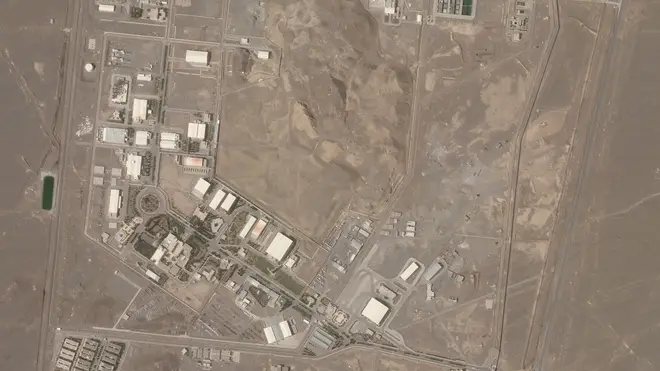
Shelagh Fogarty 1pm - 4pm
11 April 2021, 10:44

The incident happened just hours after new advanced centrifuges which more quickly enrich uranium were started up.
Iran’s Natanz nuclear site suffered a problem involving its electrical distribution grid on Sunday, just hours after starting up new advanced centrifuges which more quickly enrich uranium, state TV reported.
It was the latest incident to strike one of Tehran’s most secure sites amid negotiations over the troubled atomic accord with world powers.
Power had been cut across the facility of above-ground workshops and underground enrichment halls, civilian nuclear programme spokesman Behrouz Kamalvandi told Iranian state television.
“Here the power has been cut off indeed, and we do not know the reason for the outage,” he said. “The incident is under investigation and we will inform you about the reason as we find out.”
The word state television used in its reports attributed to Mr Kamalvandi in Farsi also can be used for “accident”.
The Vienna-based International Atomic Energy Agency, which monitors Iran’s programme, said it was “aware of the media reports”, but declined to comment.
Malek Shariati Niasar, a politician who serves as spokesman for the Iranian parliament’s energy committee, wrote on Twitter that the incident was “very suspicious”. raising concerns about possible “sabotage and infiltration”.
He said politicians are also seeking details of the incident.

Natanz, a facility earlier targeted by the Stuxnet computer virus, was largely built underground to withstand enemy air strikes.
It became a flashpoint for Western fears about Iran’s nuclear programme in 2002, when satellite photos showed Iran building its underground centrifuges facility at the site, some 125 miles (200km) south of the capital, Tehran.
Natanz suffered a mysterious explosion at its advanced centrifuge assembly plant in July which authorities later described as sabotage. Iran now is rebuilding that facility deep inside a nearby mountain.
Israel, Iran’s regional arch enemy, has been suspected of carrying out an attack there, as well as launching other assaults, as world powers now negotiate with Tehran in Vienna over its nuclear deal.
Iran also blamed Israel for the killing of a scientist who began the country’s military nuclear programme decades earlier.
Israel has not claimed any of the attacks, though Prime Minister Benjamin Netanyahu has repeatedly described Iran as a major threat to his country in recent weeks.
Israeli officials could not immediately be reached for comment. However, in a speech on Sunday, the Israeli army’s chief of staff, Lieutenant General Aviv Kochavi, appeared to refer to Iran.
The Israeli military’s “operations in the Middle East are not hidden from the eyes of the enemy”, he said. “They are watching us, seeing (our) abilities and weighing their steps with caution.”
US Defence Secretary Lloyd Austin flew to Israel on Sunday for talks with Mr Netanyahu and Israeli Defence Minister Benny Gantz.
Meanwhile, in Tehran, Iranian officials awaited the arrival of South Korean Prime Minister Chung Sye-kyun, the first visit by a premier from Seoul since before the 1979 Islamic Revolution.
On Friday, Iran released a South Korean oil tanker held since January amid a dispute with Seoul over billions of dollars of its assets frozen there.

Natanz today hosts the country’s main uranium enrichment facility. In its long underground halls, centrifuges rapidly spin uranium hexafluoride gas to enrich uranium.
On Saturday, Iran announced that it had launched a chain of 164 IR-6 centrifuges at the plant.
Officials also began testing the IR-9 centrifuge, which they say will enrich uranium 50 times faster than Iran’s first-generation centrifuges, the IR-1. The nuclear deal limited Iran to using only IR-1s for enrichment.
Since then-President Donald Trump withdrew the US from the Iran nuclear deal in 2018, Tehran has abandoned all the limits of its uranium stockpile. It now enriches up to 20% purity, a technical step away from weapons-grade levels of 90%.
Iran maintains its atomic programme is for peaceful purposes, but fears about Tehran having the ability to make a bomb saw world powers reach the deal with the Islamic Republic in 2015.
The deal lifted economic sanctions on Iran in exchange for it limiting its programme and allowing inspectors from the International Atomic Energy Agency to keep a close watch on its work.
On Tuesday, an Iranian cargo ship said to serve as a floating base for Iran’s paramilitary Revolutionary Guard forces off the coast of Yemen was struck by an explosion, most likely from a limpet mine.
Iran has blamed Israel for the blast.
That attack escalated a long-running shadow war in Middle East waterways targeting shipping in the region.